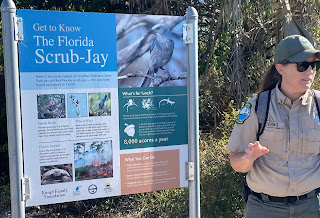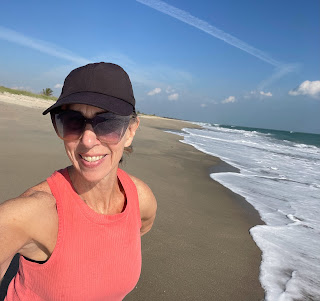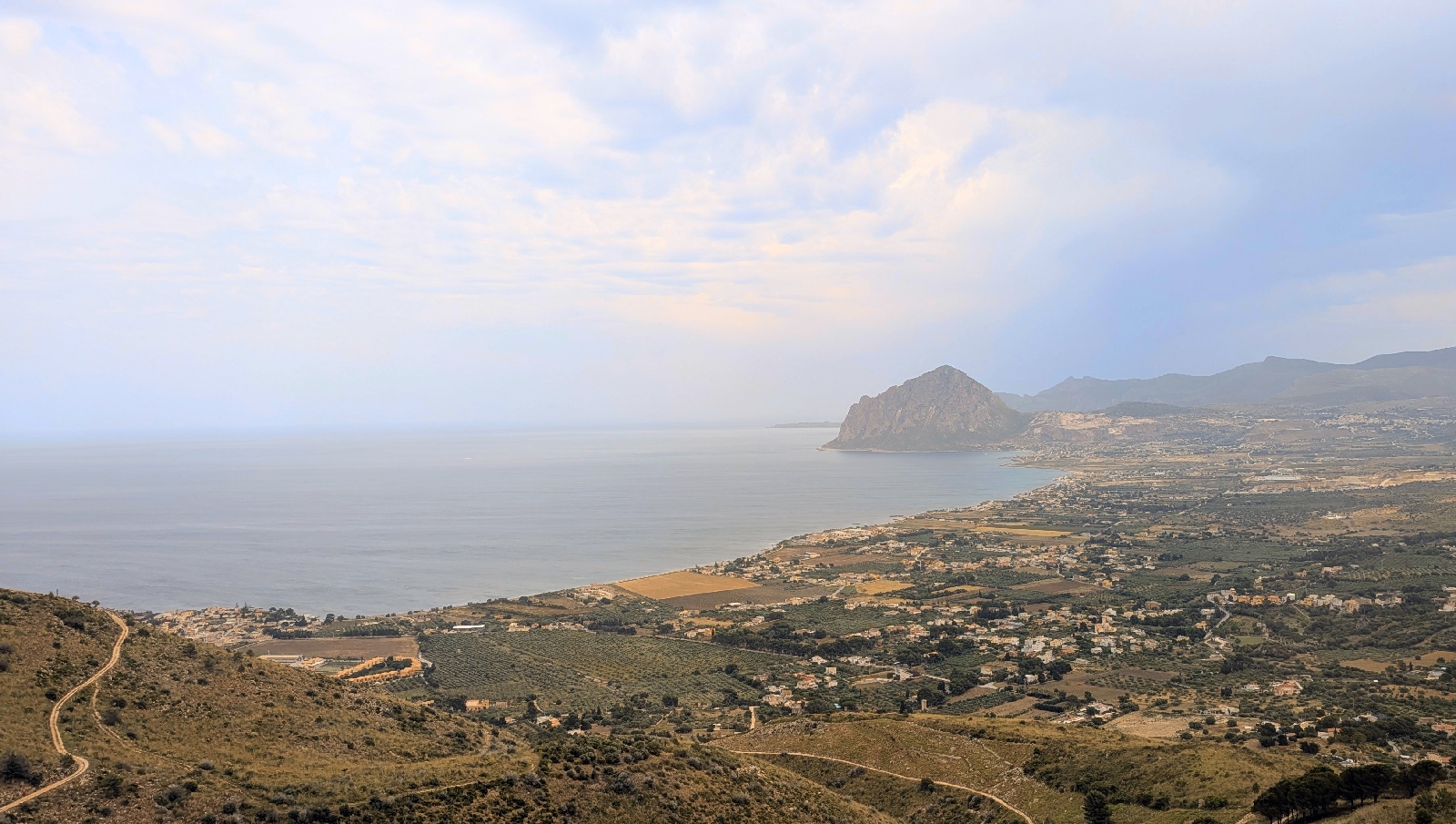Nature, History and Exploring
Monday Feb 27, I dropped Deb S and Sheri off at the Orlando airport and then headed back to Hobe Sound. I spent the rest of the day cleaning, unpacking and in the pool and relaxing.
A week or so earlier, I had signed up at the Hobe Sound Nature Refuge for a few different spring events that they were doing. The first one was on Tuesday Feb 28 and was the Jonathan Dickinson scrub jay walk. We took a walk in an area of the state park that has been set aside for increasing the Florida Scrub Jay population. It is the only bird found exclusively in Florida and it lives in family groups in a scrub habitat. When they started the project several years ago, there were 30 in the park. Now there are 200. The male and female look identical, and you can only tell them apart by one of the calls that the female makes. They take turns being a lookout, gatherer, or taking care of the young.
While on the walk, we also saw a WWII radar station that was hidden in the scrub. They did this so enemy planes or ships couldn’t see them.
As a side note: Thought to be the oldest habitat in Florida, scrub habitat formed 10,000 to 100,000 years ago when sea levels were higher. As the seas rose and retreated, sandy island ridges formed from coastal dunes, creating patches of isolated land. Plants are mostly low lying, deep rooted and sturdy. They include scrub oak, a couple of pines, saw palms and various vines and flowering plants.
This scrub jay came right up to us and was chattering away.
Our trusty state park guide - she knew what she was talking about.
These 2 were juveniles in the family group.
These 2 pictures are of the WWII hidden radar station.
On Wednesday March 1, I visited the oldest structure in Martin county that was originally built to be a House of Refuge for shipwrecked persons. It was commissioned in 1873 by the U.S. Life Saving Service (that later became the Coast Guard). There were originally 5 built and later became 10 along the coast or Florida, 29 miles apart. Many ships (often treasure ladened) would take the Gulf Stream to go north and south, but could be blown off course. It was especially treacherous on the reefs and rocks along the treasure coast of Florida. The treasure coast is an area roughly from Hobe Sound (north of west Palm Beach) in the south and Sebastian Inlet (south of Melbourne) in the north. It was said that before these houses of refuge, if you wrecked on the treasure coast and south that there was 0% chance of survival!
This house of refuge was also used as a naval station during WWII. I didn’t know this, but the Germans had torpedoed a ship just off Jupiter Sound on Feb 21, 1942. The papers were not allowed to print that news and newspaper reporter that wasn’t allowed to write about it, wrote about it in 1977!
The George Valentine shipwrecked right off the house of refuge Oct 16 1904. It is now a Florida underwater archeological preserve. Mahogany Wood cargo from the ship was used to build many things in the area.
House of Refuge
I’m right in front of the cistern. During the wars, when the navy used this station, the porch was enclosed with screens. Most likely to keep the mosquitoes and other bugs out.
The house is now a museum and the staff was really nice. I said that I was going to go eat my lunch on the beach and they offered for me to eat it on the house of refuge porch. This was my view.
More view from the house/museum.
The rocks in the pictures above and below, are called the Anastasia rock formation. They are found on the east coast of Florida and are made up of quartz sands, calcite and fossils. It is the same rock as found at the Blowing Rocks preserve. And they are the rocks that ships wrecked on all along the coast.
Ever since the naturalist at blue springs state park told us that a great blue heron could put its beak through a human skull, I look at them with a lot more respect! These 2 pictures were taken at the House of Refuge beach area.
Thursday March 2, I drove further than normal and went to Heathcote Botanical Gardens in Fort Pierce. It was small but nice and had the largest public collection of tropical bonsai in the US.
Amazon Lily
This was my favorite bonsai. The style was called forest.
Coy fish in the Japanese garden.
Do I look hot? 🥵 It was 90 degrees!
These were in the cacti garden.
Friday March 3, I stayed close to home and took a long walk on the local beach, and did some shopping. In the evening, I headed out to a marina bar in Stuart and met some fun people from New Jersey.
Wildlife refuge beach just north of Hobe Sound public beach.
Saturday March 4, I went on a touristy 4.5-hour boat ride down the intercoastal waterway from Stuart to Jupiter. We saw a couple of dolphins playing in our wake, an osprey dive and catch its meal, miles of beautiful coastline and very expensive houses. Even though it was 90 and sunny, I was able to find some shade, meet some nice people and really enjoyed the ride.
View of Jupiter lighthouse from the boat.
Top deck, there was plenty of room for everyone.
I had to include this picture because right off the bow of the boat you can see a splash. That was the best picture that I could get of the 2 dolphins playing.
Yes…. Another selfie!
When we got off the boat a fisherman was cleaning his catch and giving the scraps to the pelicans. Easy meal for them.
To finish out the week, on Sunday March 5 I headed to a local farm market in Stuart. It really only had 2 “farm” booths, but had lots of artisan booths and fun foods to sample. Michigan’s official stone is the Petosky stone, so of course I went all the way to Florida to a local farm market to buy a petosky stone necklace! I’m glad I got to the farm market when they opened at 9, because when I left the area at noon, it seemed like every vacationer was out and crowding the roads, businesses and eateries. It went from quiet to a madhouse in just 3 hours!
The necklace is the petosky stone.




























Comments
Post a Comment